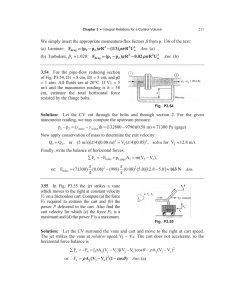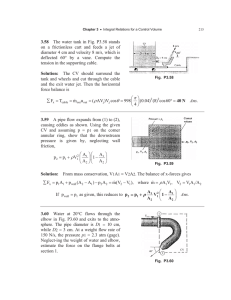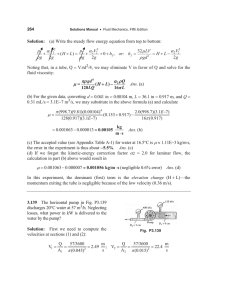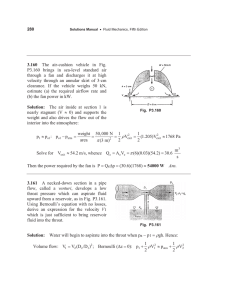Solutions
advertisement
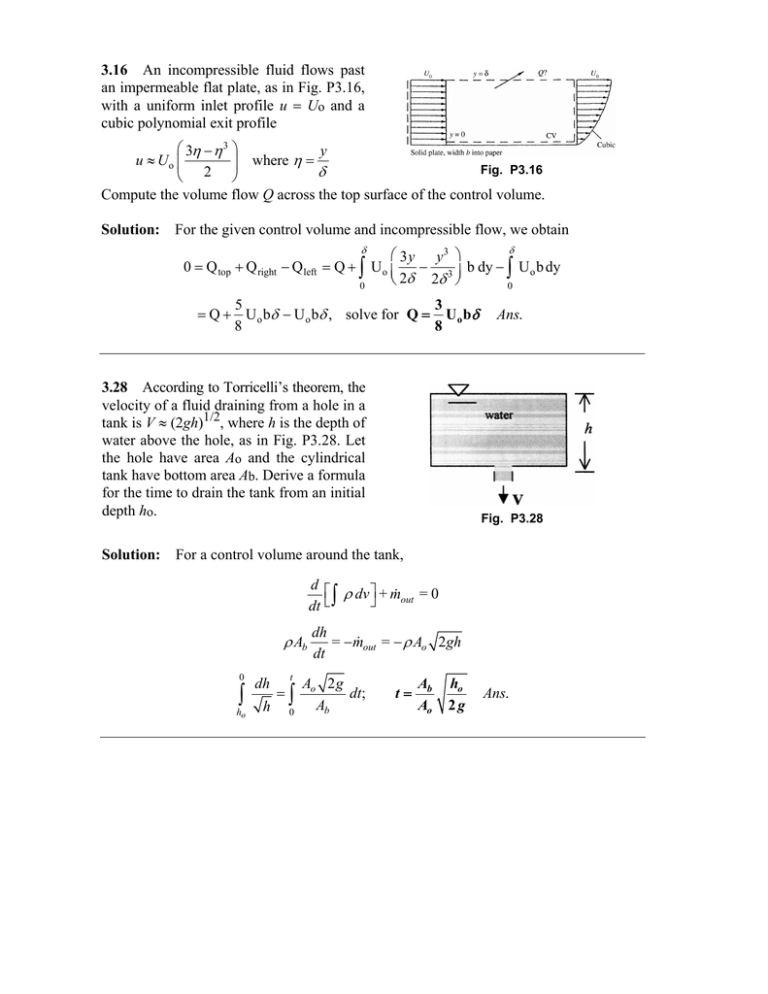
3.16 An incompressible fluid flows past an impermeable flat plate, as in Fig. P3.16, with a uniform inlet profile u = U and a o cubic polynomial exit profile ⎛ 3η − η 3 ⎞ y ≈ u U ⎟ where η = o⎜ Fig. P3.16 δ ⎝ 2 ⎠ Compute the volume flow Q across the top surface of the control volume. Solution: For the given control volume and incompressible flow, we obtain δ 0 = Q top + Q right − Q left δ ⎛ 3 y y3 ⎞ = Q + ∫ Uo ⎜ − b dy − ∫ U o b dy ⎝ 2δ 2δ 3 ⎟⎠ 0 0 5 3 = Q + U o bδ − U o bδ , solve for Q = U o bδ 8 8 Ans. According to Torricelli’s theorem, the velocity of a fluid draining from a hole in a tank is V ≈ (2gh)1/2, where h is the depth of water above the hole, as in Fig. P3.28. Let the hole have area Ao and the cylindrical tank have bottom area Ab. Derive a formula for the time to drain the tank from an initial depth ho. 3.28 Solution: For a control volume around the tank, d ⎡ ρ dv ⎤⎦ + m out = 0 dt ⎣ ∫ ρ Ab Fig. P3.28 0 ∫ ho dh h t =∫ 0 dh = − m out = − ρ Ao 2gh dt Ao 2 g dt; Ab t= Ab Ao ho 2g Ans. 3.54 For the pipe-flow reducing section of Fig. P3.54, D1 = 8 cm, D2 = 5 cm, and p2 = 1 atm. All fluids are at 20°C. If V1 = 5 m/s and the manometer reading is h = 58 cm, estimate the total horizontal force resisted by the flange bolts. Fig. P3.54 Solution: Let the CV cut through the bolts and through section 2. For the given manometer reading, we may compute the upstream pressure: p1 − p2 = (γ merc − γ water )h = (132800 − 9790)(0.58 m) ≈ 71300 Pa (gage) Now apply conservation of mass to determine the exit velocity: Q1 = Q2 , or (5 m/s)(π /4)(0.08 m)2 = V2 (π /4)(0.05)2 , solve for V2 ≈ 12.8 m/s Finally, write the balance of horizontal forces: 2 − V1 ), ∑ Fx = −Fbolts + p1,gage A1 = m(V or: Fbolts = (71300) π 4 (0.08)2 − (998) π 4 (0.08)2 (5.0)[12.8 − 5.0] ≈ 163 N Ans. 3.55 In Fig. P3.55 the jet strikes a vane which moves to the right at constant velocity Vc on a frictionless cart. Compute (a) the force Fx required to restrain the cart and (b) the power P delivered to the cart. Also find the cart velocity for which (c) the force Fx is a maximum and (d) the power P is a maximum. Fig. P3.55 Solution: Let the CV surround the vane and cart and move to the right at cart speed. The jet strikes the vane at relative speed Vj − Vc. The cart does not accelerate, so the horizontal force balance is ∑ Fx = −Fx = [ ρ A j (Vj − Vc )](Vj − Vc ) cosθ − ρ A j (Vj − Vc )2 or: Fx = ρ A j (Vj − Vc )2 (1 − cosθ ) Ans. (a) The power delivered is P = Vc Fx = ρ A j Vc (Vj − Vc )2 (1 − cosθ ) Ans. (b) The maximum force occurs when the cart is fixed, or: Vc = 0 Ans. (c) The maximum power occurs when dP/dVc = 0, or: Vc = Vj /3 Ans. (d) 3.170 If losses are neglected in Fig. P3.170, for what water level h will the flow begin to form vapor cavities at the throat of the nozzle? Solution: Applying Bernoulli from (a) to (2) gives Torricelli’s relation: V2 = √(2gh). Also, V1 = V2 (D2 /D1 )2 = V2 (8/5)2 = 2.56V2 Fig. P3.170 Vapor bubbles form when p1 reaches the vapor pressure at 30°C, pvap ≈ 4242 Pa (from Table A.5), while ρ ≈ 996 kg/m3 at 30°C (Table A.1). Apply Bernoulli between 1 and 2: p1 ρ + V 21 2 + gz1 ≈ p2 ρ + V 22 2 + gz 2 , or: 4242 (2.56V2 )2 100000 V 22 + +0≈ + +0 996 2 996 2 Solve for V 22 = 34.62 = 2gh, or h = 34.62/[2(9.81)] ≈ 1.76 m Ans. In the spillway flow of Fig. P3.176, the flow is assumed uniform and hydrostatic at sections 1 and 2. If losses are neglected, compute (a) V2 and (b) the force per unit width of the water on the spillway. 3.176 Solution: For mass conservation, V2 = V1h1 /h 2 = Fig. P3.176 (a) Now apply Bernoulli from 1 to 2: p1 γ + V12 2g 5.0 V1 = 7.14V1 0.7 Solve for V 21 = + h1 ≈ p2 γ + V 22 2g + h 2 ; or: 0 + V12 2g + 5.0 ≈ 0 + (7.14V1 )2 + 0.7 2g 2(9.81)(5.0 − 0.7) m m , or V1 = 1.30 , V2 = 7.14V1 = 9.28 2 s s [(7.14) − 1] Ans. (a) (b) To find the force on the spillway (F ←), put a CV around sections 1 and 2 to obtain ∑ Fx = − F + γ 2 h12 − γ 2 2 − V1 ), or, using the given data, h 22 = m(V 1 N F = (9790)[(5.0)2 − (0.7)2 ] − 998[(1.30)(5.0)](9.28 − 1.30) ≈ 68300 m 2 Ans. (b) 3.178 For the water channel flow of Fig. P3.178, h1 = 0.45 ft, H = 2.2 ft, and V1 = 16 ft/s. Neglecting losses and assuming uniform flow at sections 1 and 2, find the downstream depth h2. Show that two realistic solutions are possible. The analysis is quite similar to Prob. 3.177 - continuity + Bernoulli: Solution: V2 = V1 h1 16(0.45) = ; h2 h2 Fig. P3.178 V12 V2 V12 (7.2/h 2 )2 + h1 = 2 + h 2 + H = + 0.45 = + h 2 + 2.2 2g 2g 2(32.2) 2(32.2) Combine into a cubic equation: h 32 − 2.225 h 22 + 0.805 = 0 . The three roots are: h 2 = −0.540 ft (impossible); h 2 = +2.03 ft (subcritical); h 2 = +0.735 ft (supercritical) Ans.
